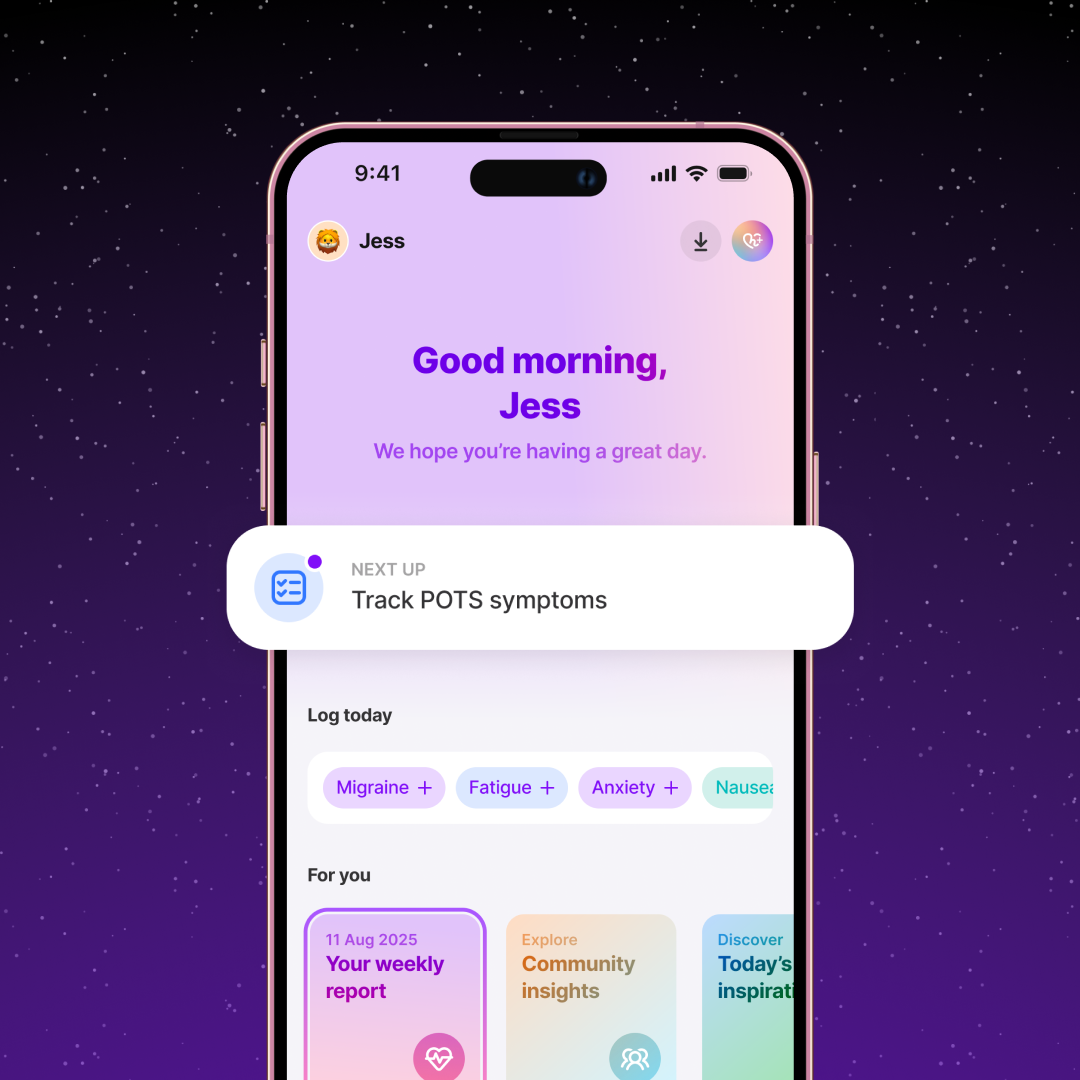MCAS and POTS: Connection, Shared Symptoms & How to Manage
November 5, 2025
.png)
- MCAS (Mast Cell Activation Syndrome) and POTS (Postural Orthostatic Tachycardia Syndrome) are distinct conditions that can overlap, leading to shared symptoms like dizziness, fatigue, and brain fog.
- Research suggests these disorders may be connected through immune system activation, connective tissue issues, or autonomic dysfunction, but the exact link is still being studied.
- Because symptoms can flare and overlap, tracking them can help individuals and healthcare providers spot patterns and triggers.
- A coordinated, symptom-tracking approach (including medication review and lifestyle adjustments) may support better management of both conditions.
Disclaimer: Human Health is a health tracking platform and does not provide medical advice, diagnosis, or treatment. The information below is for educational purposes only and is designed to support, not replace, conversations with qualified healthcare professionals.
If you’ve been told you have MCAS or POTS, or both, you may have noticed how often their symptoms seem to overlap. The fatigue, dizziness, or flushing that comes and goes can make daily life unpredictable and confusing.
These conditions are increasingly studied for potential connections. While research is still evolving, many clinicians and patients report that MCAS and POTS can occur together.
In this article, we’ll unpack the possible connection between MCAS and POTS, explore shared symptoms, discuss why they may coexist, and outline practical ways to track and manage them, so you can work more effectively with your healthcare team.
What is the link between MCAS and POTS?
Mast Cell Activation Syndrome (MCAS) is a condition where mast cells, immune cells that release chemicals like histamine, become overly reactive and can trigger symptoms such as flushing, hives, or gastrointestinal discomfort, even without a clear allergen.
Postural Orthostatic Tachycardia Syndrome (POTS) is a form of autonomic dysfunction where heart rate increases excessively upon standing. People with POTS often experience dizziness, palpitations, or fainting when they move to an upright position.
Emerging research suggests that MCAS and POTS may share overlapping biological mechanisms such as immune activation, connective tissue differences, and autonomic nervous system dysregulation. Some clinicians have observed overlap in patients with Ehlers-Danlos syndrome (EDS), forming what is sometimes called the “trifecta” of MCAS, POTS, and EDS.
While no single explanation fits everyone, understanding this potential link can help patients and clinicians take a more holistic view of symptoms and care approaches.
Possible shared symptoms of MCAS and POTS
Because MCAS and POTS can affect multiple body systems, some individuals experience a mix of overlapping symptoms. Not everyone will have all of them, and their severity can vary daily from person to person. Tracking when and how these symptoms appear can help uncover personal patterns and triggers.
#1: Dizziness or lightheadedness
In POTS, dizziness and lightheadedness can happen when standing up because the heart rate increases more than usual. In MCAS, the release of chemicals such as histamine can cause blood vessels to widen, which may also lead to feeling faint or unsteady.
#2: Fatigue and energy fluctuations
Fatigue is a frequent symptom in both POTS and MCAS. In POTS, it may happen because blood flow doesn’t always reach muscles and the brain as efficiently. In MCAS, it can be linked to inflammation and the release of chemicals such as histamine. Tracking sleep quality, hydration, and flare days can help identify what makes tiredness better or worse.
#3: Gastrointestinal distress
Abdominal pain, nausea, and bloating can affect people with either condition. In MCAS, the release of chemicals such as histamine may irritate the digestive system. In POTS, the body’s automatic functions that control digestion may not work as smoothly, which can slow the movement of food through the gut. Together, these effects can make eating unpredictable.
#4: Brain fog and concentration issues
Some individuals describe a feeling of mental “cloudiness” or trouble concentrating, often called brain fog. In POTS, studies suggest this may happen because blood flow to the brain can drop temporarily when standing. In MCAS, chemicals such as histamine and cytokines may affect how the brain’s signaling works, which can also make thinking or focusing feel harder. Tracking when brain fog appears, along with hydration and meals, can help identify possible triggers.
#5: Flushing, Itching, or Skin Reactions
In MCAS, the release of chemicals such as histamine may cause flushing, itching, or hives. Some individuals with POTS, particularly those who also have mast cell activation, report similar flushing episodes. These may be linked to changes in blood vessel response or sensitivity to temperature.
#6: Headaches and migraines
Headaches or migraines can occur in both MCAS and POTS. In MCAS, the release of chemicals such as histamine may cause blood vessels to widen, which can trigger headaches. In POTS, factors such as dehydration or changes in blood flow may also increase headache risk.
Keeping a daily symptom log in the Human Health app can make it easier to spot patterns between POTS flare-ups and possible triggers.
Top Tip: When symptoms flare, write down what was happening in the hours beforehand: meals, stress, temperature, or activity level. Over time, these notes can reveal patterns that help you and your doctor spot possible triggers or trends.
Why do MCAS and POTS often coexist?
Scientists are still learning why MCAS and POTS sometimes occur together. The exact cause isn’t clear, but several ideas may help explain the overlap.
Immune system activation
Both conditions may involve changes in how the immune system communicates. In MCAS, mast cells release inflammatory chemicals more easily. In POTS, inflammation and immune activity may affect how the nervous system controls heart rate and blood flow.
Connective tissue fragility
Some individuals with Ehlers-Danlos syndrome (EDS) also experience MCAS or POTS. Because EDS affects connective tissue, it may influence blood vessel support and immune signaling, which could explain why these conditions sometimes appear together.
Autonomic nervous system dysfunction
The autonomic nervous system controls body functions like heart rate, digestion, and temperature. When it doesn’t work properly, as seen in POTS, it may also change how mast cells behave, which can make symptoms more noticeable.
These shared biological pathways may explain why the conditions often coexist and why managing one can sometimes influence the other.
{{inline-cta-1}}
Can my MCAS medications make my POTS worse? (and vice versa)
Because MCAS and POTS can overlap in the body, some treatments for one condition may also influence the other.
For example, certain antihistamines, especially older types, may cause drowsiness or a drop in blood pressure, which could make dizziness from POTS feel worse. On the other hand, some doctors note that beta-blockers, sometimes used for POTS, might increase mast cell activity in sensitive individuals, possibly making fatigue or brain fog more noticeable.
This doesn’t mean these medicines are unsafe. It simply shows that everyone’s body reacts differently. Tracking how you respond to any new or adjusted medication can help your healthcare provider find the best balance for you.
{{pro-tip-1}}
Diagnostic challenges: MCAS vs POTS
Because MCAS and POTS can share so many symptoms, getting an accurate diagnosis can take time. Both require specific testing and clinical observation, and it’s common for patients to see multiple specialists before finding answers.
How doctors diagnose POTS
POTS is often diagnosed using a tilt-table test or active stand (supine to standing) evaluations. These measure changes in heart rate and blood pressure when moving from lying down to standing. A sustained increase in heart rate (often 30 beats per minute or more) without a significant blood pressure drop supports a POTS diagnosis.
How doctors diagnose MCAS
Doctors diagnose MCAS by looking for typical symptoms, such as flushing, hives, or stomach discomfort, along with lab tests showing higher levels of mast cell chemicals like tryptase or histamine. A diagnosis is further supported if symptoms improve with antihistamines or other medications that calm mast cells.
Why misdiagnosis happens
Many symptoms of MCAS and POTS (fatigue, dizziness, brain fog) overlap with other conditions, making misdiagnosis common. Some patients are told their symptoms are anxiety-related before receiving a proper evaluation.
Keeping a consistent symptom log, including timing, triggers, and severity, can help doctors recognize patterns and confirm whether both conditions may be involved.
How to manage MCAS and POTS
Managing MCAS and POTS together often means finding small, consistent habits that help stabilize the body’s responses. Because each person’s experience is unique, it’s best to work closely with a healthcare provider to tailor strategies and review medications regularly.

#1: Identify and track your triggers
Many patients with MCAS report that their flares are triggered by factors such as certain foods, temperature shifts (heat or cold), stress, or certain medications. Using a symptom tracker helps you notice what precedes your worst days. Over time, this data can help you and your doctor adjust routines or treatments more effectively.
#2: Focus on hydration and electrolytes
People with POTS often benefit from increased fluids and electrolytes to help maintain blood volume, and those with MCAS may need to avoid drinks that trigger histamine release. Logging what you drink (and how you feel afterward) helps balance both needs safely.
See the best electrolyte options for POTS.
#3: Support the nervous system
Gentle movement, compression garments, and slow changes in posture can help improve circulation and reduce dizziness. Pairing these with relaxation techniques or pacing routines can help calm the body’s stress response.
#4: Optimize your environment and nutrition
Temperature swings, allergens, or certain foods may trigger or worsen MCAS flares. Working with a dietitian or allergist to identify triggers and track reactions can reduce daily discomfort.
Try these natural POTS relief tips to feel more steady.
#5: Collaborate and adjust regularly
Regularly review your symptom data with healthcare professionals. Adjusting medications, routines, and supplements under medical guidance helps refine what works best for you.
Use the Human Health app to log symptoms, hydration, and medications daily. Over time, your reports can help identify flare patterns and guide more informed conversations with your healthcare provider.

Track MCAS & POTS symptoms with the Human Health app
When you’re managing complex conditions like MCAS and POTS, small details matter. When symptoms appear, what triggers them, and how your body responds to medications, routines, or daily activities can all make a difference. Trying to remember it all can feel overwhelming.
The Human Health app helps simplify this process. You can:
- Log daily symptoms, flares, and triggers in real time
- Track medications, hydration, and activity levels
- Share detailed PDF summaries with your healthcare team
- Manage multiple profiles if you’re tracking for a family member
By collecting your data in one place, you gain clearer insights into how your body reacts, and your doctor gets a more accurate picture to guide care decisions. You can start tracking your MCAS and POTS symptoms in the Human Health app today and share your personalized health summary at your next appointment.
With consistent tracking, you’ll have the information you need for more informed, confident conversations with your healthcare provider.
Disclaimer: Human Health is a health tracking platform and does not provide medical advice, diagnosis, or treatment. The information on this site is intended to support, not replace, discussions with qualified healthcare professionals.
References
- National Library of Medicine: Mast cell activation syndrome: An up-to-date review of literature
- National Library of Medicine: Postural Orthostatic Tachycardia Syndrome
- National Institute of Neurological Disorders and Stroke: Postural Tachycardia Syndrome (POTS)
- Frontiers: Association of postural orthostatic tachycardia syndrome, hypermobility spectrum disorders, and mast cell activation syndrome in young patients; prevalence, overlap and response to therapy depends on the definition
- National Library of Medicine: Mast Cell Activation Syndrome and Gut Dysfunction: Diagnosis and Management
- National Library of Medicine: What is brain fog? An evaluation of the symptom in postural tachycardia syndrome
- Europe PMC: Mast cell activation mediates blood-brain barrier impairment and cognitive dysfunction in septic mice in a histamine-dependent pathway.
- National Library of Medicine: Hyperadrenergic postural tachycardia syndrome in mast cell activation disorders
- Annals of Allergy, Asthma & Immunology: Mast cells in the autonomic nervous system and potential role in disorders with dysautonomia and neuroinflammation
- Journal of the American Heart Association: Mast Cell Activation Disorder and Postural Orthostatic Tachycardia Syndrome: A Clinical Association
- Dysautonomia International: Postural Orthostatic Tachycardia Syndrome
- National Library of Medicine: H1 Antihistamines: Current Status and Future Directions
This is a div block with a Webflow interaction that will be triggered when the heading is in the view.


Track your POTS and MCAS symptoms with the Human Health app
Get a clearer picture of when and why your MCAS or POTS symptoms worsen, so you can take preventive action before flare-ups hit.







Pro tip
When starting or changing any medication, track your symptoms daily for at least two weeks. Note when doses are taken, any side effects, and overall energy or dizziness levels. Even small details can help your healthcare provider see how your body is responding and adjust your plan safely.

.jpg)





.png)

